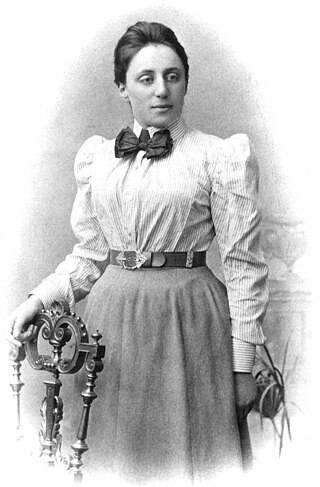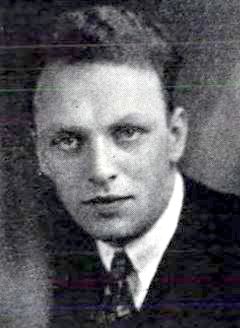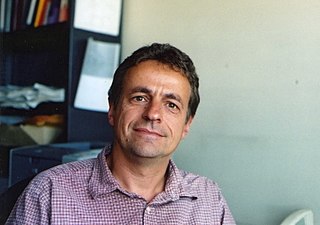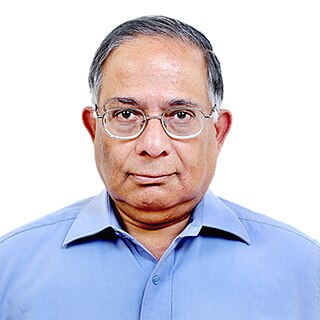Related Research Articles

Alain Connes is a French mathematician, known for his contributions to the study of operator algebras and noncommutative geometry. He is a professor at the Collège de France, Institut des Hautes Études Scientifiques, Ohio State University and Vanderbilt University. He was awarded the Fields Medal in 1982.

Algebraic geometry is a branch of mathematics which uses abstract algebraic techniques, mainly from commutative algebra, to solve geometrical problems. Classically, it studies zeros of multivariate polynomials; the modern approach generalizes this in a few different aspects.
In mathematics, a Noetherian ring is a ring that satisfies the ascending chain condition on left and right ideals; if the chain condition is satisfied only for left ideals or for right ideals, then the ring is said left-Noetherian or right-Noetherian respectively. That is, every increasing sequence of left ideals has a largest element; that is, there exists an n such that:

Amalie Emmy Noether was a German mathematician who made many important contributions to abstract algebra. She proved Noether's first and second theorems, which are fundamental in mathematical physics. She was described by Pavel Alexandrov, Albert Einstein, Jean Dieudonné, Hermann Weyl and Norbert Wiener as the most important woman in the history of mathematics. As one of the leading mathematicians of her time, she developed theories of rings, fields, and algebras. In physics, Noether's theorem explains the connection between symmetry and conservation laws.

Commutative algebra, first known as ideal theory, is the branch of algebra that studies commutative rings, their ideals, and modules over such rings. Both algebraic geometry and algebraic number theory build on commutative algebra. Prominent examples of commutative rings include polynomial rings; rings of algebraic integers, including the ordinary integers ; and p-adic integers.
In algebra, ring theory is the study of rings—algebraic structures in which addition and multiplication are defined and have similar properties to those operations defined for the integers. Ring theory studies the structure of rings, their representations, or, in different language, modules, special classes of rings, as well as an array of properties that proved to be of interest both within the theory itself and for its applications, such as homological properties and polynomial identities.
In mathematics, a von Neumann algebra or W*-algebra is a *-algebra of bounded operators on a Hilbert space that is closed in the weak operator topology and contains the identity operator. It is a special type of C*-algebra.
Noncommutative geometry (NCG) is a branch of mathematics concerned with a geometric approach to noncommutative algebras, and with the construction of spaces that are locally presented by noncommutative algebras of functions, possibly in some generalized sense. A noncommutative algebra is an associative algebra in which the multiplication is not commutative, that is, for which does not always equal ; or more generally an algebraic structure in which one of the principal binary operations is not commutative; one also allows additional structures, e.g. topology or norm, to be possibly carried by the noncommutative algebra of functions.
In functional analysis, a branch of mathematics, an operator algebra is an algebra of continuous linear operators on a topological vector space, with the multiplication given by the composition of mappings.

William B. Arveson was a mathematician specializing in operator algebras who worked as a professor of Mathematics at the University of California, Berkeley.
In abstract algebra, a representation of an associative algebra is a module for that algebra. Here an associative algebra is a ring. If the algebra is not unital, it may be made so in a standard way ; there is no essential difference between modules for the resulting unital ring, in which the identity acts by the identity mapping, and representations of the algebra.

Øystein Ore was a Norwegian mathematician known for his work in ring theory, Galois connections, graph theory, and the history of mathematics.
In ring theory and homological algebra, the global dimension of a ring A denoted gl dim A, is a non-negative integer or infinity which is a homological invariant of the ring. It is defined to be the supremum of the set of projective dimensions of all A-modules. Global dimension is an important technical notion in the dimension theory of Noetherian rings. By a theorem of Jean-Pierre Serre, global dimension can be used to characterize within the class of commutative Noetherian local rings those rings which are regular. Their global dimension coincides with the Krull dimension, whose definition is module-theoretic.

Bernd Sturmfels is a Professor of Mathematics and Computer Science at the University of California, Berkeley and is a director of the Max Planck Institute for Mathematics in the Sciences in Leipzig since 2017.
Noncommutative algebraic geometry is a branch of mathematics, and more specifically a direction in noncommutative geometry, that studies the geometric properties of formal duals of non-commutative algebraic objects such as rings as well as geometric objects derived from them.
In mathematics, a positive polynomial (respectively non-negative polynomial) on a particular set is a polynomial whose values are positive (respectively non-negative) on that set. Precisely, Let p be a polynomial in n variables with real coefficients and let S be a subset of the n-dimensional Euclidean space ℝn. We say that:
Fred Van Oystaeyen, also Freddy van Oystaeyen, is a mathematician and emeritus professor of mathematics at the University of Antwerp. He has pioneered work on noncommutative geometry, in particular noncommutative algebraic geometry.
Mathematics is a broad subject that is commonly divided in many areas that may be defined by their objects of study, by the used methods, or by both. For example, analytic number theory is a subarea of number theory devoted to the use of methods of analysis for the study of natural numbers.

Joachim Cuntz is a German mathematician, currently a professor at the University of Münster.

Kalyan Bidhan Sinha is an Indian mathematician. He is a professor at the Jawaharlal Nehru Centre for Advanced Scientific Research, and Professor Emeritus for life of the Indian Statistical Institute.